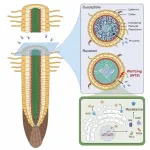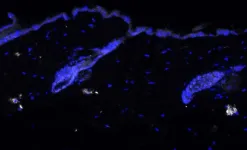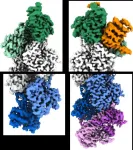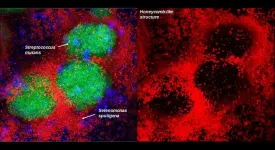A potential milestone in cancer therapy
A previously unknown weakpoint of prostate cancer cells could lead to entirely new therapeutic approaches for other types of cancer.
2023-06-08
(Press-News.org)
Prostate cancer is the most common non-skin cancer in men worldwide. According to international estimates about one in six men will get prostate cancer during their lifetime and worldwide, over 375’000 patients will die from it each year. Tumor resistance to current therapies plays an essential role in this and new approaches are therefore urgently needed. Now an international research team from the University of Bern, Inselspital Bern and the University of Connecticut (USA) has identified a previously unknown weak spot in prostate cancer cells. This weak spot is possibly also present in other cancer cells. The study was led by Mark Rubin from the Department for Biomedical Research (DBMR) and Center for Precision Medicine (BCPM) at the University of Bern and Inselspital Bern, and Rahul Kanadia from the Department of Physiology and Neurobiology and the Institute for Systems Genomics at the University of Connecticut. The research results have now been published in the journal Molecular Cell.
Previously unknown driver of prostate cancer identified"We took a closer look at a certain molecular machine called the spliceosome", explains Anke Augspach, lead author of the study and researcher from the Department for BioMedical Research (DBMR). "It plays an important role in the translation of genes into proteins. In this process, the spliceosome separates parts of the gene that are not needed for the production of the protein and fuses the other parts."
While almost all genes undergo this process in the so-called major spliceosome, the minor spliceosome is used in less than one percent of genes. “Nevertheless, the minor spliceosome is enormously important because it particularly processes genes that play a crucial role in cell growth. And it is this cell growth that gets out of control in cancer – but the precise mechanism behind this remained unclear“, explains Rahul Kanadia, study co-author from the Physiology and Neurobiology Department and the Institute for Systems Genomics at the University of Connecticut.
In their investigations, the team found various indications for the central role of the minor spliceosome in cancer. “We were able to show that a specific component of the minor spliceosome is significantly increased in advanced prostate cancer”, explains study co-author Mark Rubin of the Department for BioMedical Research (DBMR) and Bern Center for Precision Medicine (BCPM). This led the researchers to suspect that cancer cells activate the minor spliceosome through this component and thus stimulate uncontrolled cell growth.
An entirely new approach to cancer therapies
The researchers were able to confirm their assumption with the help of laboratory test models such as 2D cell cultures and organoids – miniature organs that are grown in the laboratory based on patient samples. They were also able to show that inhibiting the specific component led to a greater reduction in the growth of prostate cancer than current standard therapies. “Accordingly, blocking this process should hold therapeutic potential.”, Mark Rubin says. “This is the target that that we were hunting”. Rahul Kanadia adds that "The blocking leads to a decrease in cancer growthwithout affecting the growth and survival of normal cells." "This discovery is a game changer in developing more effective and targeted combination therapies for cancers such as prostate cancer and other types of cancer. We want to work on this in the coming years – and have already applied for the corresponding patent", Rubin concludes.
Research supported with 1 million dollars
The research results come from a project supported by the US Prostate Cancer Foundation (PCF) with the Igor Tulchinsky-Leerom Segal-PCF Challenge Award 2022. The foundation funds interdisciplinary projects that pursue promising approaches to combat recurrent or advanced prostate cancer. The award is endowed with 1 million dollars. “We commend the research team on their achievement and proudly support their work to bring us closer to our mission to eliminate death and suffering from prostate cancer”, says Howard R. Soule, Executive Vice President and Chief Science Officer of the PCF.
END
ELSE PRESS RELEASES FROM THIS DATE:
2023-06-08
June 8, 2023 — Showing people how their behavior compares to their peers is a commonly used method to improve behavior. But in the wake of a global pandemic that exacerbated health care providers’ job dissatisfaction and burnout, questions remain about the potentially negative effects of peer comparison on the well-being of clinicians.
A new study from the USC Schaeffer Center for Health Policy & Economics reveals fresh insights into the relationship between peer comparison and job satisfaction among clinicians. Published in JAMA Network Open, the study challenges prior findings that such feedback increases job dissatisfaction and burnout.
Researchers ...
2023-06-08
Researchers led by CHEN Yuhang and ZHOU Jianmin from the Institute of Genetics and Developmental Biology of the Chinese Academy of Sciences have shown how plants resist clubroot, a major root disease that threatens the productivity of Brassica crops such as rape.
The study, which uncovers novel mechanisms underlying plant immunity and promises a new avenue for crop breeding, was published in Cell.
Clubroot, a soil-borne disease, is the most devastating disease of Brassica crops. In China, approximately 3.2–4 million hm2 of agricultural land is affected by clubroot each year, resulting in a 20%–30% yield ...
2023-06-08
A team of researchers from IRB Barcelona and CNAG identifies the IL-17 protein as a determining factor in skin ageing.
Blocking the function of IL-17 reduces the pro-inflammatory state and delays the appearance of age-related features in the skin.
Published in the journal Nature Aging, the work opens up new perspectives in the development of therapies to improve skin ageing health.
A team of scientists from the Institute for Research in Biomedicine (IRB Barcelona) in collaboration with the National ...
2023-06-08
Each year, about 200,000 people in the United States are diagnosed with a bulge in the lower part of the aorta, the main artery in the body, called an abdominal aortic aneurysm (AAA).
New research from the University of Cincinnati examines the role a particular metabolite plays in the development of AAA and could lead to the first treatment of the condition.
The research was published in the journal Circulation.
“We started the study by examining whether AAA patients themselves had an increase in trimethylamine N-oxide (TMAO). We examined an American and Swedish ...
2023-06-08
Actin filaments — protein structures critical to living movement from single cells to animals — have long been known to have polarity associated with their physical characteristics, with growing “barbed” and shrinking “pointed” ends. The ends of the filament are also different in the way they interact with other proteins in cells. However, the mechanism that determines these differences has never been entirely clear to scientists. Now, researchers from the Perelman School of Medicine at the University of Pennsylvania have revealed key atomic structures of ...
2023-06-08
Nutrition is an important part of any top athlete’s training program. And now, a new study by researchers from the University of Georgia proposes that supplementing the diet of athletes with colorful fruits and vegetables could improve their visual range.
The paper, which was published in Exercise and Sport Sciences Reviews, examines how a group of plant compounds that build up in the retina, known as macular pigments, work to improve eye health and functional vision.
Previous studies done by UGA researchers Billy R. Hammond and ...
2023-06-08
A new framework for making better and more transparent decisions about the use of our land could help to balance society’s demands upon it with protecting and enhancing the environment.
Researchers led by the University of Leicester have proposed a framework for decisions on land use, from nationwide policymaking to building happening at street level, that would involve the most representative range of stakeholders, from those with financial interests in the land to the local communities who use it and more besides.
Now published in the journal People and Nature, it encourages decisionmakers ...
2023-06-08
Patients suffering from the “most horrible” rare brain tumour are falling through the cracks of mental health provision, University of Essex researchers have found.
A recent study which interviewed patients and clinicians discovered survivors struggle to access therapy available for other serious illnesses, such as cancer, and there was a lack of specialised support.
For the first time, the mental health of British rare brain tumour patients was examined by psychologists and now researchers are calling for urgent changes to the health service.
Dr Katie Daughters hopes her findings –published in ...
2023-06-08
PHILADELPHIA— Historically, scientists have studied how cells develop and give rise to specialized cells, such as heart, liver, or skin cells, by examining specific proteins. However, it remains unclear how many of these proteins influence the activity of hundreds of genes at the same time to turn one cell type into another cell type. For example, as the heart develops, stem cells and other specialized cells will give rise to heart muscle cells, endothelial cells (lining of blood vessels), smooth muscle cells, and cardiac fibroblasts. But the details of this process remain mysterious.
As a result of a $6 million, seven-year ...
2023-06-08
Philadelphia — Collaborating researchers from the University of Pennsylvania School of Dental Medicine and the Adams School of Dentistry and Gillings School of Global Public Health at the University of North Carolina have discovered that a bacterial species called Selenomonas sputigena can have a major role in causing tooth decay.
Scientists have long considered another bacterial species, the plaque-forming, acid-making Streptococcus mutans, as the principal cause of tooth decay—also known as dental caries. However, in the study, which appeared 22 May in Nature Communications, the Penn Dental Medicine and UNC researchers showed that S. sputigena, previously associated ...
LAST 30 PRESS RELEASES:
[Press-News.org] A potential milestone in cancer therapy
A previously unknown weakpoint of prostate cancer cells could lead to entirely new therapeutic approaches for other types of cancer.




